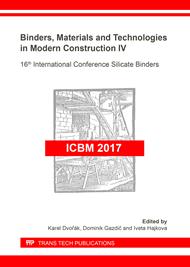p.41
p.47
p.53
p.60
p.69
p.75
p.83
p.89
p.97
Influence of Cellulose Ethers on Fresh State Properties of Lime Mortars
Abstract:
Cellulose ethers (CEs) are widely used as viscosity enhancing, water retaining additives in cement based mortars. Nevertheless, studies about the effect of cellulose ethers on the properties of aerial lime-based mortars are very lack. The use of water retaining additives in lime mortars can influence not only their fresh state properties but also the pore structure and strength of hardened mortars. In this work, four different commercial cellulose ethers were added to lime mortars in order to test their influence on properties of mortars in the fresh state. Mortar rheological parameters (relative yield stress, consistency coefficient and fluidity index) were correlated with flow table tests, relative density measurements, water retention and air content in the mortars. It was found that CEs reduce the spread of lime mortars and increase air content in the mortars. The CEs are not so effective in water retention compared with other types of water retention agents. Most dosages of CEs change the behaviour of mortars from pseudoplastic to dilatant. In contrast to the effect of CEs in cement-based materials, their viscosity enhancing behavior in lime mortars is denied, due to the presence of large amounts of calcium hydroxide. From this point of view, the CEs are not so suitable to use as viscosity enhancing admixtures in lime mortars like derivatives of chitosan or guar gum.
Info:
Periodical:
Pages:
69-74
Citation:
Online since:
June 2018
Authors:
Keywords:
Price:
Сopyright:
© 2018 Trans Tech Publications Ltd. All Rights Reserved
Share:
Citation:


